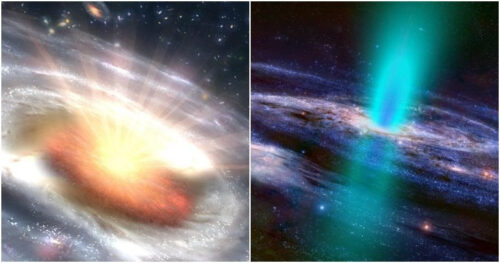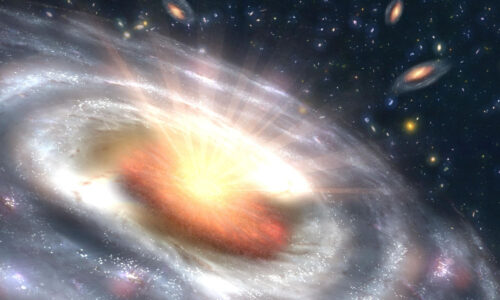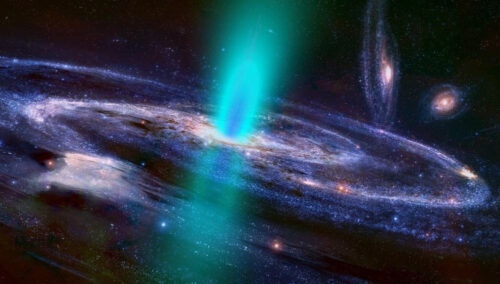
The birth and evolution of galaxies have long captivated astronomers and cosmologists. New revelations from the James Webb Space Telescope (JWST) have shed light on the astonishing growth of galaxies in the early stages of the universe, painting a picture of awe-inspiring celestial giants.
In a groundbreaking study led by Xuheng Ding and John Silverman of the Kavli Institute for the Physics and Mathematics of the Universe, researchers have unveiled two massive galaxies as they appeared less than a billion years after the universe’s inception.
These cosmic behemoths possess central supermassive black holes that raise intriguing questions about their rapid growth. In this article, we explore the fascinating findings and seek to unravel the mystery of the galaxies and their black holes in the nascent universe.
The Rapid Rise of Galaxies
Less than a billion years after the Big Bang, early galaxies began undergoing remarkable transformations, putting on considerable mass. The researchers’ observations using the JWST have unveiled a galaxy that weighs a staggering 130 billion times the mass of our Sun.
This cosmic heavyweight is accompanied by a black hole-driven quasar boasting a mass of 1.4 billion solar masses. The intriguing aspect is that the relationship between the galaxy’s size and its central black hole defies conventional expectations. The researchers are faced with two pressing questions: How did these galaxies amass such incredible mass in the infancy of the universe, and which came first, the galaxies or the black holes?
Galactic Growth Spurts and Supermassive Black Holes
Understanding the rapid growth of galaxies and their central supermassive black holes poses a significant challenge for astrophysicists. The prevailing theory suggests that galaxies grow through a process of hierarchical merging, where smaller galaxies combine to form more massive structures.
Similarly, supermassive black holes are thought to grow through accretion, accumulating mass by devouring surrounding matter. However, the observed size disparities between these early galaxies and their black holes complicate this explanation.

One hypothesis proposes that the central black holes formed first and then rapidly triggered the growth of their host galaxies. The intense radiation emitted by the active nucleus of a quasar could have influenced the surrounding gas, instigating a surge in star formation and galactic growth. This scenario suggests that the black hole’s immense mass and activity drive the subsequent growth of the galaxy.
Another theory posits that the galaxies formed first, accumulating mass through hierarchical merging. As these galaxies collided and merged, their central black holes also merged, resulting in even more massive black holes. This scenario suggests that the galaxy’s growth is responsible for the black hole’s growth.
Resolving the Puzzle
To disentangle this cosmic puzzle, researchers are employing advanced computational models and simulations. These tools help recreate the conditions of the early universe and track the formation and growth of galaxies and their black holes.
By comparing the observed data from the JWST with the simulated models, scientists can test various hypotheses and refine our understanding of galactic evolution.
Additionally, the study of distant quasars, which provide insights into the early universe, can further elucidate the relationship between galaxies and their central black holes.
By analyzing the emission lines in quasar spectra, astronomers can discern the properties of the surrounding gas and infer the conditions that fostered galactic growth.

Implications and Future Prospects
Unveiling the secrets of early galaxies and their supermassive black holes holds profound implications for our understanding of the cosmos.
By investigating the cosmic dawn, when the universe transitioned from darkness to a sea of illuminated galaxies, scientists can gain insights into the fundamental processes that shaped the universe as we know it today.
The discoveries made by the JWST and ongoing research endeavors offer exciting prospects for future exploration.
With the launch of more powerful telescopes and technological advancements, scientists will delve even deeper into the enigmatic nature of galaxies and black holes. By probing the furthest reaches of the cosmos, we inch closer to solving the riddles of the infant universe and illuminating the cosmic tapestry of our existence.
The recent revelations brought forth by the JWST and the diligent efforts of researchers like Xuheng Ding and John Silverman have unraveled tantalizing glimpses of the early universe.
The extraordinary growth of galaxies and their massive black holes within a billion years after the Big Bang challenges our current understanding of cosmic evolution.

As scientists strive to solve the conundrum of galactic growth, we inch closer to unraveling the mysteries of the infant universe and gaining a deeper appreciation for the grandeur and complexity of our cosmic origins.
